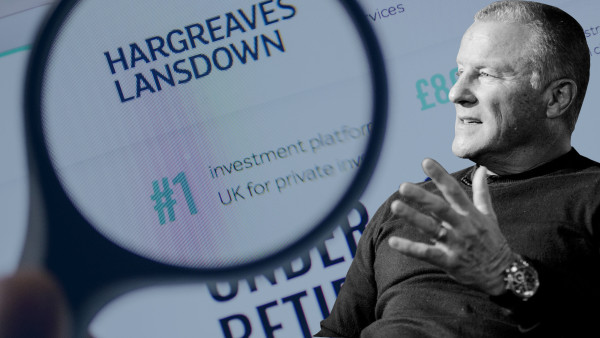

Hargreaves Lansdown is facing legal action over its role in promoting Woodford Equity Income, but questions remain over how the industry has moved on, if at all, from the fund's collapse.
The platform has declined to comment on the prospective litigation, which - coupled with Woodford's own attempted comeback, has returned the issue to the spotlight almost two years after the fund was first suspended.
What, though, has really changed for the industry? Hargreaves, for one, has made a number of changes to its best buylist practices in the aftermath of the demise of the Equity Income fund, which was suspended almost in June 2019 after proving unable to meet a series of redemption requests.
Last year, Hargreaves launched its Wealth Shortlist, a move it said was in response to client feedback and industry and market conditions. As part of this it also said it was clarifying and increasing the transparency of its selection criteria.
It already had a number of governance arrangements in place to oversee decision-making in relation to its multi-manager funds and wealth lists, including the use of its investment committee and product governance committee.
Then, last year, it introduced some enhancements to its governance and oversight arrangements, including: setting up a separate executive investment committee to oversee decision-making in relation to its MMFs; and a new distribution investment oversight committee that oversees investment decision-making and risk for the platform, including oversight of its Wealth Shortlist.
But how damaging has the Woodford association been for Hargreaves, and what are the wider repercussions for the industry?
The immediate aftermath
In 2019 Chris Hill, chief executive of Hargreaves Lansdown, told the Treasury Select Committee that there were 133,769 Hargreaves clients with direct exposure to the fund, then named LF Woodford Equity Income. They owned units worth £1.1bn, which represented 1.1 per cent of Hargreaves' total assets under administration.
The average direct investor holding in Woodford was £8,152, with 50 per cent of Hargreaves' clients holding less than £4,000 and 20 per cent holding less than £1,000.
The total number of directly and indirectly exposed Hargreaves clients was 291,520 – amounting to around a quarter of all customers.
Indirectly exposed clients are those who own units in funds that have an underlying exposure to the Equity Income fund, including the Hargreaves multi-manager range.
“This means 76 per cent of our clients have no direct or indirect exposure to the Woodford Equity Income fund. Collectively, the total exposure of Hargreaves' clients is £1,619m. This represents under 1.7 per cent of Hargreaves' total AUM,” Hill added.
But despite exposure to the now defunct Equity Income fund being partly to blame for the underperformance of certain Hargreaves funds, according to the platform’s assessment of value report in February, it gained a record 84,00 new customers in the second half of 2020. The boom in retail investing seen during lockdown has more than compensated for any long-term fallout from the Woodford affair - if that fallout exists at all.
Mike Barrett, director at the Lang Cat, says: “[The Woodford association] has clearly not been [Hargreaves'] finest moment, and there are a number of lessons to be learnt. However, it appears to have had little, if any, impact on their new customer acquisition numbers, or retention rates.”
While legal proceedings are in their early stages and will be watched closely by all those in the retail investment world, questions remain over the repercussions for the wider industry.
Ryan Hughes, head of active portfolios at AJ Bell, says: “Every aspect of the Woodford situation... from how the fund was marketed, to the perspective of how the Financial Conduct Authority reviewed [the situation]; all of that has been damaging to the industry and the investor perception of our industry, which is really important, as it undermines lots of the good work the vast majority of people in the industry do.
“It undermines trust at a time when people need to save for their future and retirement more than ever. You undo that confidence [by] investing in ultimately what should be some fairly mainstream funds... [but then] push them into things that are less suitable and, ultimately, could lead to worse customer outcomes.
“[But] this is important for investors to remember: there are thousands of funds and investments out there operating in the regulatory environment, and a significant failure of one of those funds is incredibly rare.”
Barrett says the most significant repercussions he expects to see in the industry will be increased governance and oversight for fund managers, platforms and authorised corporate directors.
“In particular I’d like to see the existing Prod rules enforced more strongly," he adds. "These require product manufacturers to clearly define their target clients, and to ensure their products meet their needs. Product distributors carry similar responsibilities. These rules are in place now, but need to be enforced more rigorously.”
Best-buy lists
The closure of the Equity Income fund has brought best-buy lists under the microscope.
One of the points that RGL is focusing on in its case is that Hargreaves harboured concerns about the Equity Income fund as far back as November 2017 – 18 months before the fund was suspended in June 2019.
Yet the platform continued to recommend the fund in its best-buy list right up to the day of its collapse.
Buy lists remain a common feature on direct-to-consumer platforms in particular.
Behavioural economics suggests that when people are presented with an extremely wide or unfamiliar choice, for example about financial planning, they can end up not making any decision at all.
In its Investment Platforms Market Study, the FCA found that, on average, 17 per cent of non-advised platform clients use best-buy lists.
For less experienced consumers or those new to investing, best-buy lists and/or model portfolios appear to provide a useful tool in making decisions when choosing from a full range of funds.
The FCA also found that best-buy lists do add value by identifying funds that perform better than funds not on the list.
But Bella Caridade-Ferreira, chief executive of Fundscape, says there needs to be better checks and balances for buy lists and its gatekeepers.
“The big issue for me is we do need to think about whether we should regulate these lists. Hargreaves recognises that it has a lot of influence. It had the funds on its list for quite a while, and probably should have removed it before, but it was not the only one,” Caridade-Ferreira says.
“We have the assessment of value funds for individual funds. We could do assessment of value reports for model portfolios, or we could do other types of reviews.
“It is one of the reasons we set up our gatekeepers project to do exactly that, as there’s no way of assessing gatekeepers, or anyone who puts together a shortlist or a basket of funds; no way of comparing them.”
Barrett adds: “I do think there is a place for best-buy lists. If you removed them completely then I’m not sure that would aid consumers. Where they are used, providers need to be clearer in setting out that they are not advice, and what that means in terms of potential redress for any losses.
“Any best-buy list needs to be completely transparent about the process, and ideally have independent or non-exec oversight in the mix as well.”
AJ Bell’s Hughes explains that part of his role – investigating the type of funds that will make the fund manager's favourite funds list – involves having conversations with fund managers to understand what is happening with their products.
There may be relatively frequent occasions where a concern might prompt further investigation, but it does not necessarily change the rating or take them off the list. For instance, certain changes may have occurred in relation to the fund, for example underlying team changes, which are important but not fundamental.
However, with the Equity Income fund, Hughes says AJ Bell took the fund off its list in September 2018, the point at which it took its own favourite funds list in-house, having previously outsourced it to a third party.
“We were looking at all the information, holdings, how the portfolio was shifting, looking at the liquidity... therefore we had immediate concerns. It is really important the list is research-led," he adds.
"That means the decisions are made by the investment research team and no other team within AJ Bell, with the right governance structure in place.
“Lists have a role to play, but we would always say to anyone they need to do their own research and this is just one part of their research process.”
Ima Jackson-Obot is deputy features editor of FTAdviser



